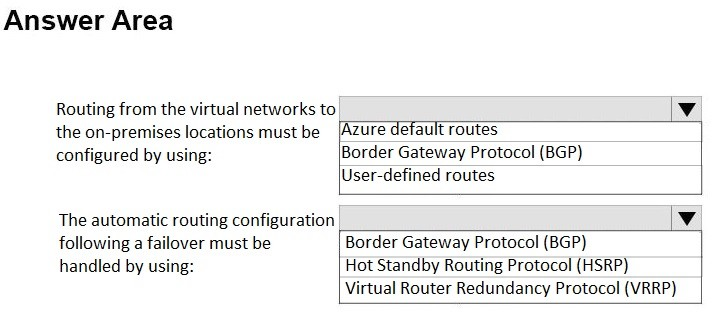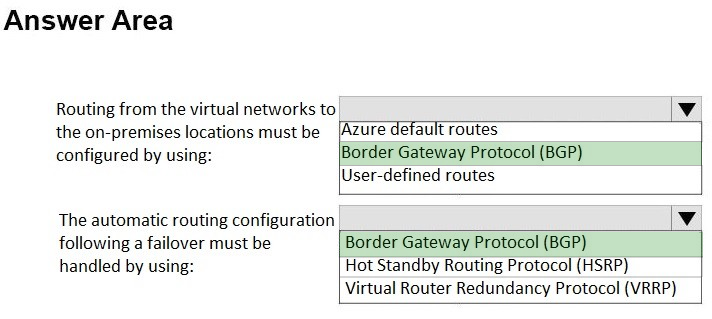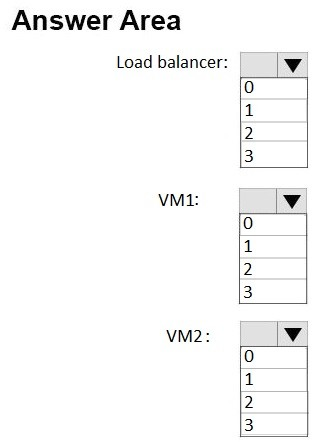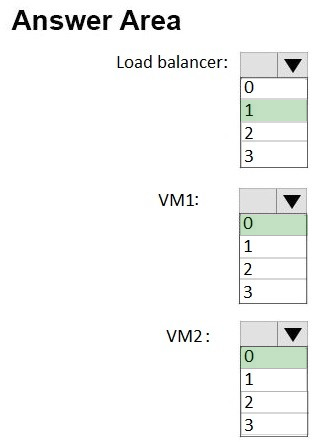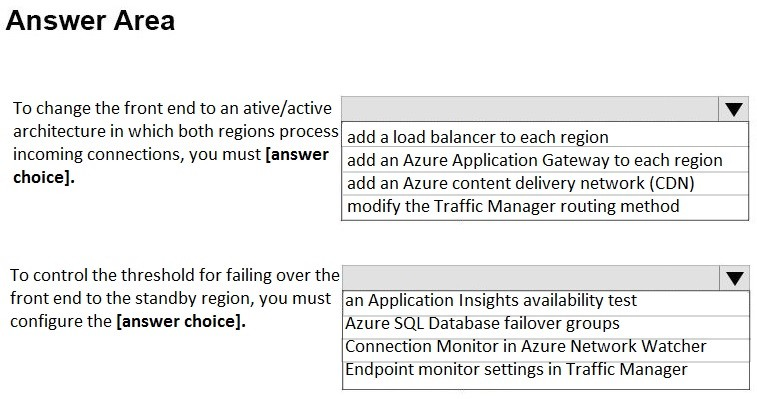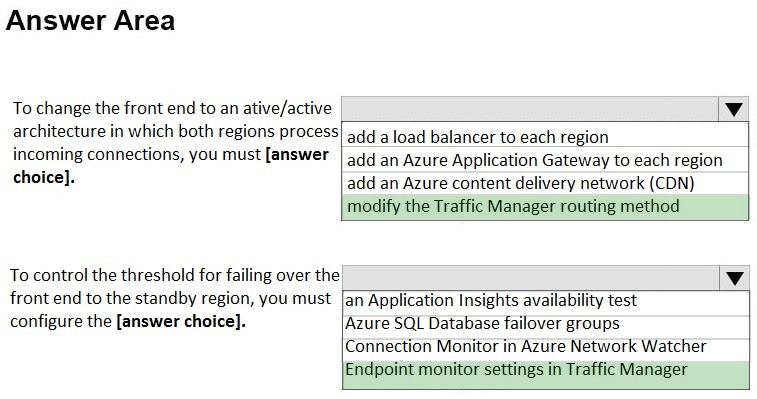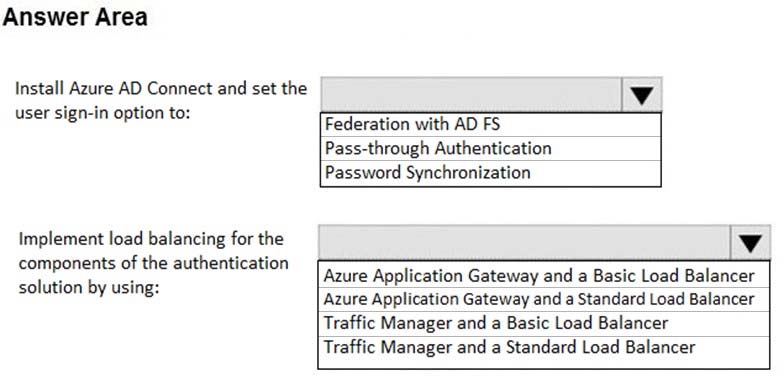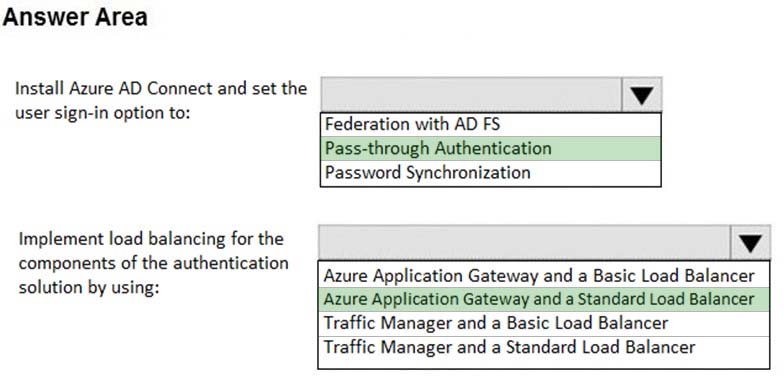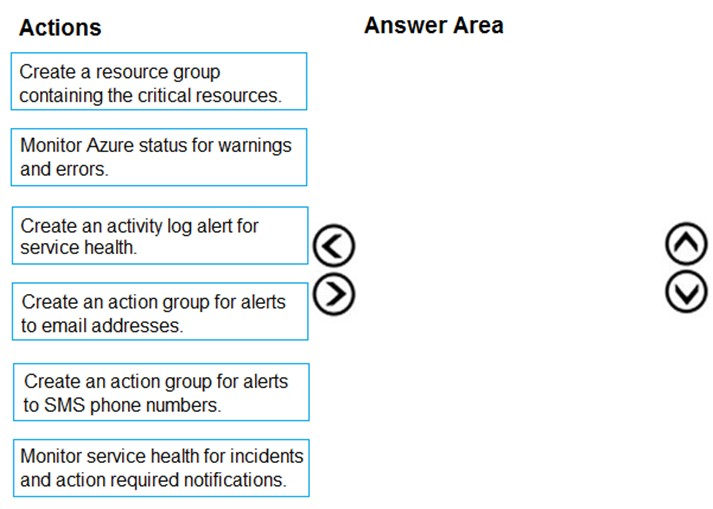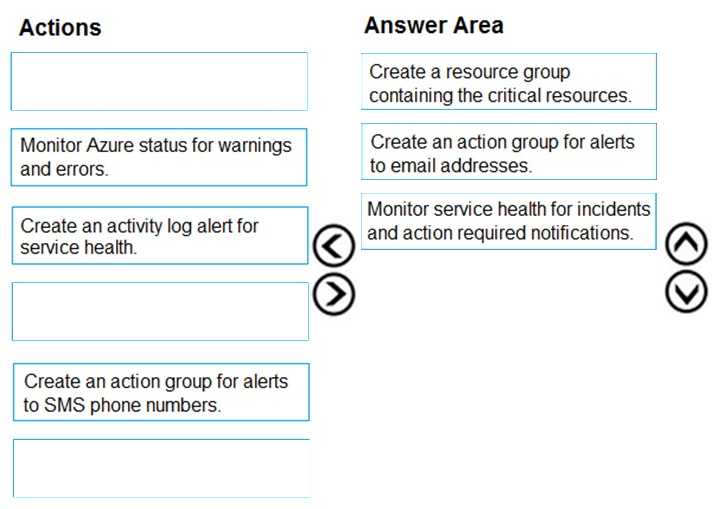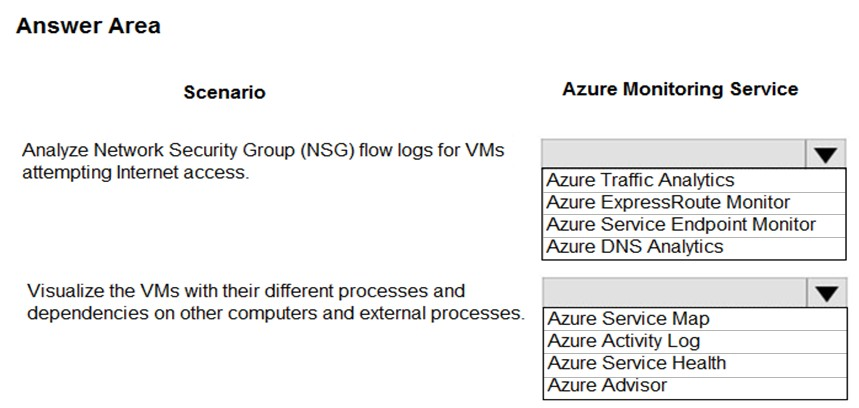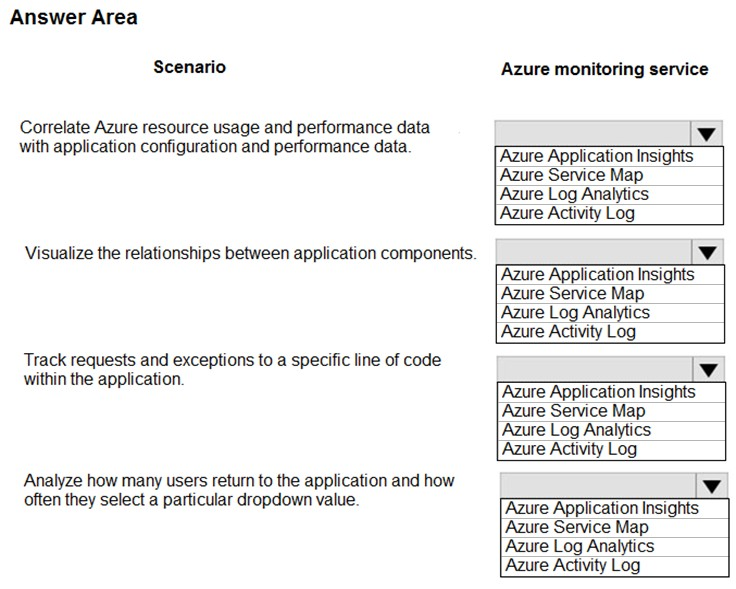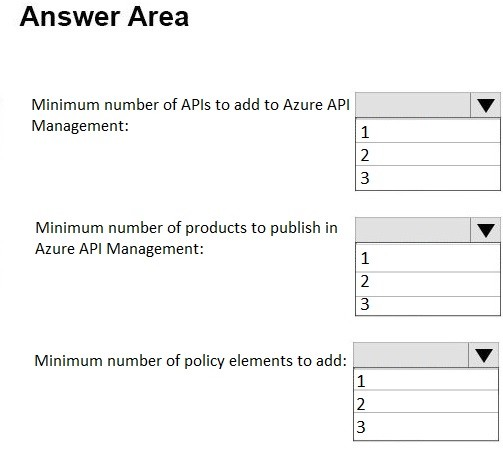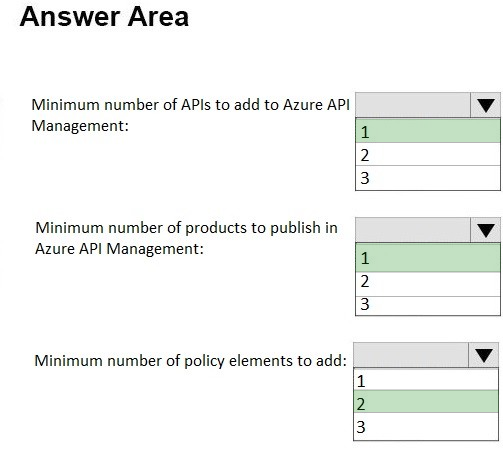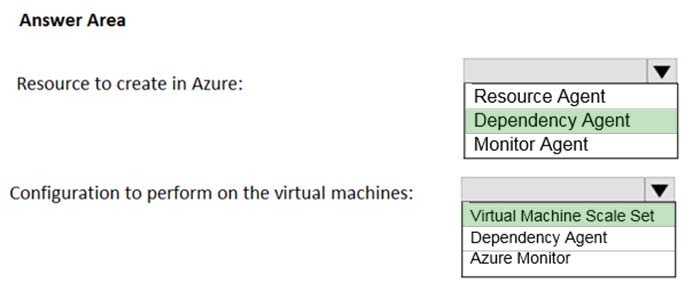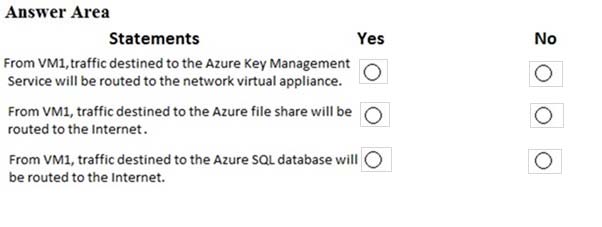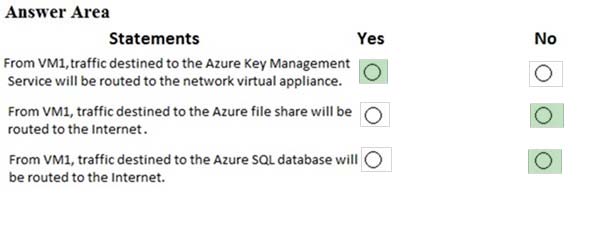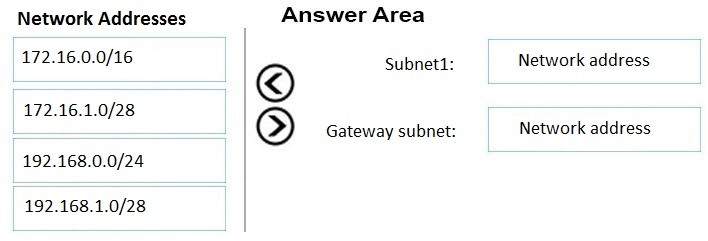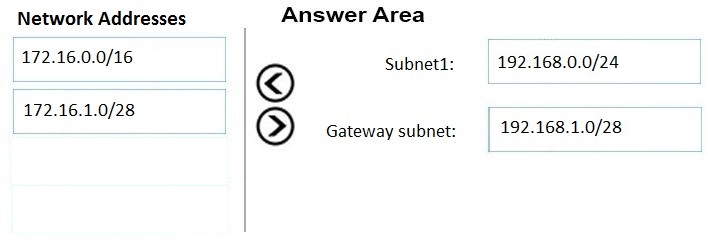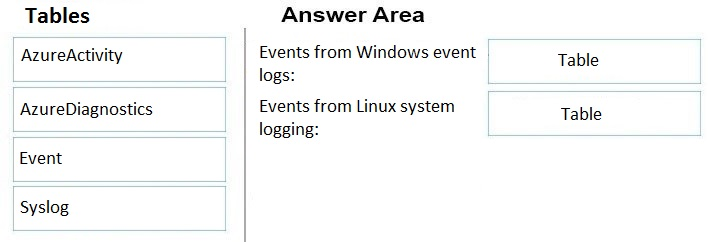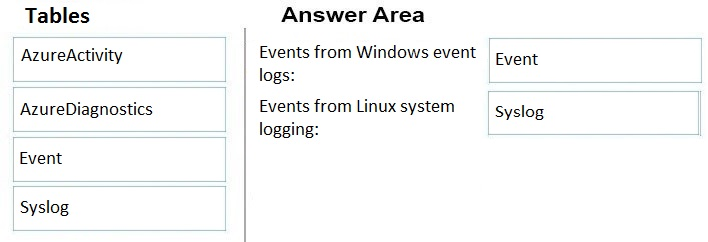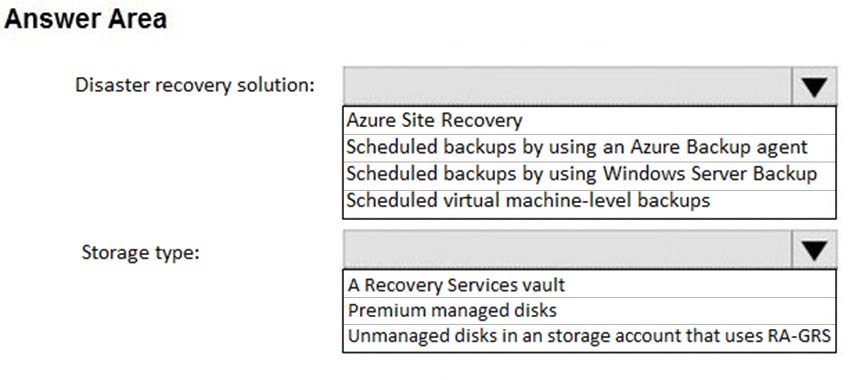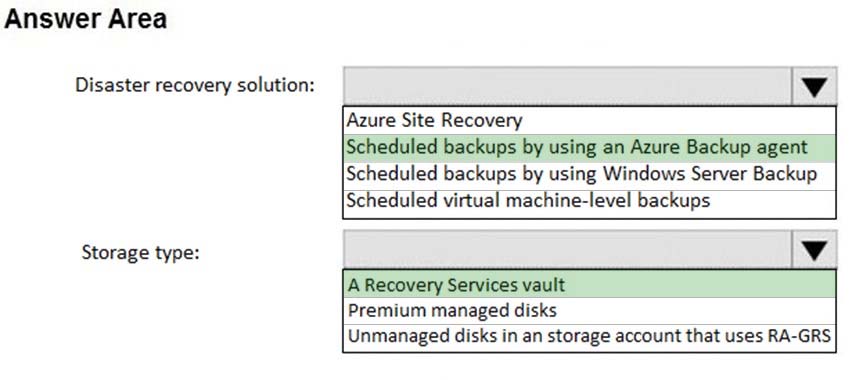AZ-301 Practice Exam Free – 50 Questions to Simulate the Real Exam
Are you getting ready for the AZ-301 certification? Take your preparation to the next level with our AZ-301 Practice Exam Free – a carefully designed set of 50 realistic exam-style questions to help you evaluate your knowledge and boost your confidence.
Using a AZ-301 practice exam free is one of the best ways to:
- Experience the format and difficulty of the real exam
- Identify your strengths and focus on weak areas
- Improve your test-taking speed and accuracy
Below, you will find 50 realistic AZ-301 practice exam free questions covering key exam topics. Each question reflects the structure and challenge of the actual exam.
You have an on-premises network and an Azure subscription. The on-premises network has several branch offices. A branch office in Toronto contains a virtual machine named VM1 that is configured as a file server. Users access the shared files on VM1 from all the offices. You need to recommend a solution to ensure that the users can access the shares files as quickly as possible if the Toronto branch office is inaccessible. What should you include in the recommendation?
A. a Recovery Services vault and Azure Backup
B. an Azure file share and Azure File Sync
C. Azure blob containers and Azure File Sync
D. a Recovery Services vault and Windows Server Backup
You have an Azure subscription that contains an Azure Blob storage account named store1. You have an on-premises file server named Server1 that runs Windows Server 2016. Server1 stores 500 GB of company files. You need to store a copy of the company files in store1. Which two possible Azure services achieve this goal? Each correct answer presents a complete solution. NOTE: Each correct selection is worth one point.
A. an Azure Import/Export job
B. an integration account
C. an Azure Batch account
D. Azure data Factory
E. an On-premises data gateway
DRAG DROP - An organization has an on-premises server that runs Windows Server 2003. The server hosts an IIS-based stateless web application that uses forms authentication. The application consists of classic Active Server Pages (ASP) pages and third-party components (DLLs) that are registered in the Windows registry. The deployment process for the web application is manual and is prone to errors. The deployment process makes it difficult to roll out updates, scale out, and recover after failures. You need to design a modernization approach for the web application that meets the following requirements: ✑ Improve the deployment process. ✑ Ensure that the application can run in the cloud. ✑ Minimize changes to application code. ✑ Minimize administrative effort required to implement the modernization solution. What should you recommend? To answer, drag the appropriate actions to the correct approaches. Each action may be used once, more than once, or not at all. You may need to drag the split bar between panes or scroll to view content. NOTE: Each correct selection is worth point. Select and Place:
You need to recommend a data storage solution that meets the following requirements: ✑ Ensures that application can access the data by using a REST connection Hosts 20 independent tables of varying sizes and usage patterns✑ Automatically replicates the data to a second Azure region ✑ Minimizes costs What should you recommend?
A. an Azure SQL Database elastic database pool that uses active geo-replication
B. tables in an Azure Storage account that uses geo-redundant storage (GRS)
C. tables in an Azure Storage account that use read-access geo-redundant storage (RA-GR)
D. an Azure SQL database that uses active geo-replication
You have a hybrid deployment of Azure Active Directory (Azure AD). You need to recommend a solution to ensure that the Azure AD tenant can be managed only from the computers on your on-premises network. What should you include in the recommendation?
A. Azure AD roles and administrators
B. a conditional access policy
C. Azure AD Application Proxy
D. Azure AD Privileged Identity Management
HOTSPOT - Your company has two on-premises sites in New York and Los Angeles and Azure virtual networks in the East US Azure region and the West US Azure region. Each on-premises site has Azure ExpressRoute circuits to both regions. You need to recommend a solution that meets the following requirements: ✑ Outbound traffic to the Internet from workloads hosted on the virtual networks must be routed through the closest available on-premises site. ✑ If an on-premises site fails, traffic from the workloads on the virtual networks to the Internet must reroute automatically to the other site. What should you include in the recommendation? To answer, select the appropriate options in the answer area. NOTE: Each correct selection is worth one point. Hot Area:
You need to recommend a solution to meet the database retention requirement. What should you recommend?
A. Configure geo-replication of the database
B. Configure Azure Site Recovery
C. Configure a long-term retention policy for the database
D. Use automatic Azure SQL Database backups
You have a web app named App1 that is hosted on-premises and on four Azure virtual machines. Each virtual machine is in a different region. You need to recommend a solution to ensure that users will always connect to the closest instance of App1. The solution must prevent the users from attempting to connect to a failed instance of App1. Which two possible recommendations achieve the goal? Each correct answer presents a complete solution. NOTE: Each correct selection is worth one point.
A. Azure Front Door Service
B. Azure Load Balancer
C. round-robin DNS
D. Azure Traffic Manager
E. Azure Application Gateway
Your company plans to publish APIs for its services by using Azure API Management. You discover that service responses include the AspNet-Version header. You need to recommend a solution to remove AspNet-Version from the response of the published APIs. What should you include in the recommendation?
A. a new product
B. a modification to the URL scheme
C. a new policy
D. a new revision
Note: This question is part of series of questions that present the same scenario. Each question in the series contains a unique solution that might meet the stated goals. Some question sets might have more than one correct solution, while others might not have a correct solution. After you answer a question in this section, you will NOT be able to return to it. As a result, these questions will not appear in the review screen. You have an Azure subscription named Project1. Only a group named Project1admins is assigned roles in the Project1 subscription. The Project1 subscription contains all the resources for an application named Application1. Your company is developing a new application named Application2. The members of the Application2 development team belong to an Azure Active Directory (Azure AD) group named App2Dev. You identify the following requirements for Application2: ✑ The members of App2Dev must be prevented from changing the role assignments in Azure. ✑ The members of App2Dev must be able to create new Azure resources required by Application2. ✑ All the required role assignments for Application2 will be performed by the members of Project1admins. You need to recommend a solution for the role assignments of Application2. Solution: In Project1, create a network security group (NSG) named NSG1. Assign Project1admins the Owner role for NSG1. Assign the App2Dev the Contributor role for NSG1. Does this meet the goal?
A. Yes
B. No
A company named Contoso, Ltd. has an Azure Active Directory (Azure AD) tenant that is integrated with Microsoft Office 365 and an Azure subscription. Contoso has an on-premises identity infrastructure. The infrastructure includes servers that run Active Directory Domain Services (AD DS), Active Directory Federation Services (AD FS), Azure AD Connect, and Microsoft Identity Manager (MIM). Contoso has a partnership with a company named Fabrikam, Inc. Fabrikam has an Active Directory forest and an Office 365 tenant. Fabrikam has the same on- premises identity infrastructure as Contoso. A team of 10 developers from Fabrikam will work on an Azure solution that will be hosted in the Azure subscription of Contoso. The developers must be added to the Contributor role for a resource in the Contoso subscription. You need to recommend a solution to ensure that Contoso can assign the role to the 10 Fabrikam developers. The solution must ensure that the Fabrikam developers use their existing credentials to access resources. What should you recommend?
A. Configure a forest trust between the on-premises Active Directory forests of Contoso and Fabrikam.
B. Configure an organization relationship between the Office 365 tenants of Fabrikam and Contoso.
C. In the Azure AD tenant of Contoso, enable Azure Active Directory Domain Services (Azure AD DS). Create a one-way forest trust that uses selective authentication between the Active Directory forests of Contoso and Fabrikam.
D. In the Azure AD tenant of Contoso, create guest accounts for the Fabrikam developers.
You need to recommend a solution for the network configuration of the front-end tier of the payment processing. What should you include in the recommendation?
A. Azure Application Gateway
B. Traffic Manager
C. a Standard Load Balancer
D. a Basic load Balancer
You need to recommend a data storage strategy for WebApp1. What should you include in the recommendation?
A. a fixed-size DTU Azure SQL database
B. an Azure virtual machine that runs SQL Server
C. an Azure SQL Database elastic pool
D. a vCore-based Azure SQL database
Note: This question is part of series of questions that present the same scenario. Each question in the series contains a unique solution that might meet the stated goals. Some question sets might have more than one correct solution, while others might not have a correct solution. After you answer a question in this section, you will NOT be able to return to it. As a result, these questions will not appear in the review screen. A company has custom ASP.NET and Java applications that run old versions of Windows and Linux. The company plans to place applications in containers. You need to design a solution that includes networking, service discovery, and load balancing for the applications. The solution must support storage orchestration. Solution: Deploy a Kubernetes cluster that has the desired number of instances of the applications. Does the solution meet the goal?
A. Yes
B. No
You manage an application instance. The application consumes data from multiple databases. Application code references database tables using a combination of the server, database, and table name. You need to migrate the application instance to Azure. What are two possible ways to achieve this goal? Each correct answer presents a complete solution. NOTE: Each correct selection is worth one point.
A. SQL Server Stretch Database
B. SQL Server in an Azure virtual machine
C. Azure SQL Database
D. SQL Managed Instance
You manage a solution in Azure. You must collect usage data including MAC addresses from all devices on the network. You need to recommend a monitoring solution. What should you recommend?
A. Activity Log Analytics
B. Azure Network Security Group Analytics
C. Network Performance Monitor
D. Azure Application Gateway Analytics
E. Azure Wire Data
HOTSPOT - You are designing a solution for a stateless front-end application named Application1. Application1 will be hosted on two Azure virtual machines named VM1 and VM2. You plan to load balance connections to VM1 and VM2 from the Internet by using one Azure load balancer. You need to recommend the minimum number of required public IP addresses. How many public IP addresses should you recommend using for each resource? To answer, select the appropriate options in the answer area. NOTE: Each correct selection is worth one point. Hot Area:
Note: This question is part of series of questions that present the same scenario. Each question in the series contains a unique solution that might meet the stated goals. Some question sets might have more than one correct solution, while others might not have a correct solution. After you answer a question in this section, you will NOT be able to return to it. As a result, these questions will not appear in the review screen. You need to deploy resources to host a stateless web app in an Azure subscription. The solution must meet the following requirements: ✑ Provide access to the full .NET framework. ✑ Provide redundancy if an Azure region fails. ✑ Grant administrators access to the operating system to install custom application dependencies. Solution: You deploy a virtual machine scale set that uses autoscaling. Does this meet the goal?
A. Yes
B. No
You need to recommend a solution for the collection of security logs for the middle tier of the payment processing system. What should you include in the recommendation?
A. the Azure Log Analytics agent
B. Azure Event Hubs
C. Azure Notification Hubs
D. the Azure Diagnostics agent
Note: This question is part of series of questions that present the same scenario. Each question in the series contains a unique solution that might meet the stated goals. Some question sets might have more than one correct solution, while others might not have a correct solution. After you answer a question in this section, you will NOT be able to return to it. As a result, these questions will not appear in the review screen. You have an Azure subscription that contains a resource group named RG1. You create an Azure Active Directory (Azure AD) group named ResearchUsers that contains the user accounts of all researchers. You need to recommend a solution that meets the following requirements: ✑ The researchers must be allowed to create Azure virtual machines. The researchers must only be able to create Azure virtual machines by using specific Azure Resource Manager templates.Solution: Create a lab in Azure DevTest Lab. Configure the DevTest Labs settings. Assign the DevTest Labs User role to the ResearchUsers group. Does this meet the goal?
A. Yes
B. No
You have an application named App1. App1 generates log files that must be archived for five years. The log files must be readable by App1 but must not be modified. Which storage solution should you recommend for archiving?
A. Use an Azure Blob storage account and a time-based retention policy
B. Ingest the log files into an Azure Log Analytics workspace
C. Use an Azure Blob Storage account configured to use the Archive access tier
D. Use an Azure file share that has access control enabled
Note: This question is part of series of questions that present the same scenario. Each question in the series contains a unique solution that might meet the stated goals. Some question sets might have more than one correct solution, while others might not have a correct solution. After you answer a question in this section, you will NOT be able to return to it. As a result, these questions will not appear in the review screen. You need to deploy resources to host a stateless web app in an Azure subscription. The solution must meet the following requirements: ✑ Provide access to the full .NET framework. ✑ Provide redundancy if an Azure region fails. ✑ Grant administrators access to the operating system to install custom application dependencies. Solution: You deploy a web app in an Isolated App Service plan. Does this meet the goal?
A. Yes
B. No
You are developing a web application that provides streaming video to users. You configure the application to use continuous integration and deployment. The app must be highly available and provide a continuous streaming experience for users. You need to recommend a solution that allows the application to store data in a geographical location that is closest to the user. What should you recommend?
A. Azure App Service Web Apps
B. Azure App Service Isolated
C. Azure Redis Cache
D. Azure Content Delivery Network (CDN)
You need to recommend a solution to generate a monthly report of all the new Azure Resource Manager resource deployments in your subscription. What should you include in the recommendation?
A. Azure Log Analytics
B. Application Insights
C. the Change Tracking management solution
D. Azure Monitor metrics
HOTSPOT - You have the application architecture shown in the following exhibit.Use the drop-down menus to select choice that completes each statement based on the information presented in the graphic. NOTE: Each correct selection is worth one point. Hot Area:
You have 100 servers that run Windows Server 2012 R2 and host Microsoft SQL Server 2012 R2 instances. The instances host databases that have the following characteristics: ✑ The largest database is currently 3 TB. None of the databases will ever exceed 4 TB. ✑ Stored procedures are implemented by using CLR. You plan to move all the data from SQL Server to Azure. You need to recommend an Azure service to host the databases. The solution must meet the following requirements: ✑ Whenever possible, minimize management overhead for the migrated databases. ✑ Minimize the number of database changes required to facilitate the migration. Ensure that users can authenticate by using their Active Directory credentials.What should you include in the recommendation?
A. Azure SQL Database single databases
B. Azure SQL Database Managed Instance
C. Azure SQL Database elastic pools
D. SQL Server 2016 on Azure virtual machines
You need to recommend a solution to generate a monthly report of all the new Azure Resource Manager resource deployments in your subscription. What should you include in the recommendation?
A. the Change Tracking management solution
B. Azure Activity Log
C. Azure Monitor action groups
D. Azure Advisor
You plan to run an image rendering workload in Azure. The workload uses parallel compute processes. What is the best service to use to run the workload? More than one answer choice may achieve the goal. Select the BEST answer.
A. an Azure virtual machine scale set
B. Azure Kubernetes Service (AKS)
C. Azure Batch
D. Azure Container Service
HOTSPOT - You need to recommend a solution for the users at Contoso to authenticate to the cloud-based services and the Azure AD-integrated applications. What should you include in the recommendation? To answer, select the appropriate options in the answer area. NOTE: Each correct selection is worth one point. Hot Area:
DRAG DROP - You plan to move several apps that handle critical line-of-business (LOB) services to Azure. Appropriate personnel must be notified if any critical resources become degraded or unavailable. You need to design a monitoring and notification strategy that can handle up to 100 notifications per hour. Which three actions should you recommend be performed in sequence? To answer, move the appropriate actions from the list of actions to the answer area and arrange them in the correct order. NOTE: More than one order of answer choices is correct. You will receive credit for any of the correct orders you select. Select and Place:
HOTSPOT - Your company deploys several Linux and Windows virtual machines (VMs) to Azure. The VMs are deployed with the Microsoft Dependency Agent and the Log Analytics Agent installed by using Azure VM extensions. On-premises connectivity has been enabled by using Azure ExpressRoute. You need to design a solution to monitor the VMs. Which Azure monitoring services should you use? To answer, select the appropriate Azure monitoring services in the answer area. NOTE: Each correct selection is worth one point. Hot Area:
You have 100 servers that run Windows Server 2012 R2 and host Microsoft SQL Server 2012 R2 instances. The instances host databases that have the following characteristics: ✑ The largest database is currently 3 TB. None of the databases will ever exceed 4 TB. ✑ Stored procedures are implemented by using CLR. You plan to move all the data from SQL Server to Azure. You need to recommend an Azure service to host the databases. The solution must meet the following requirements: ✑ Whenever possible, minimize management overhead for the migrated databases. ✑ Minimize the number of database changes required to facilitate the migration. ✑ Ensure that users can authenticate by using their Active Directory credentials. What should you include in the recommendation?
A. Azure SQL Database single databases
B. Azure SQL Database Managed Instance
C. Azure SQL Database elastic pools
D. SQL Server 2016 on Azure virtual machines
HOTSPOT - You have an Azure App Service Web App that includes Azure Blob storage and an Azure SQL Database instance. The application is instrumented by using the Application Insights SDK. You need to design a monitoring solution for the web app. Which Azure monitoring services should you use? To answer, select the appropriate Azure monitoring services in the answer area. NOTE: Each correct selection is worth one point. Hot Area:
You plan to deploy an API by using Azure API Management. You need to recommend a solution to protect the API from a distributed denial of service (DDoS) attack. What should you recommend?
A. Create network security groups (NSGs).
B. Enable quotas.
C. Enable rate limiting.
D. Strip the Powered-By responsible header.
Note: This question is part of series of questions that present the same scenario. Each question in the series contains a unique solution that might meet the stated goals. Some question sets might have more than one correct solution, while others might not have a correct solution. After you answer a question in this section, you will NOT be able to return to it. As a result, these questions will not appear in the review screen. You are designing a storage solution to support on-premises resources and Azure-hosted resources. You need to provide on-premises storage that has built-in replication to Azure. Solution: You include Azure Data Table Storage in the design. Does the solution meet the goal?
A. Yes
B. No
You plan to create an Azure Cosmos DB account that uses the SQL API. The account will contain data added by a web application. The web application will send data daily. You need to recommend a notification solution that meets the following requirements: ✑ Sends email notification when data is received from IoT devices. ✑ Minimizes compute cost. What should you include in the recommendation?
A. Deploy an Azure logic app that has the Azure Cosmos DB connector configured to use a SendGrid action.
B. Deploy a function app that is configured to use the Consumption plan and a SendGrid binding.
C. Deploy an Azure logic app that has a SendGrid connector configured to use an Azure Cosmos DB action.
D. Deploy a function app that is configured to use the Consumption plan and an Azure Event Hubs binding.
HOTSPOT - Your company has an API that returns XML data to internal applications. You plan to migrate the applications to Azure. You also plan to allow the company's partners to access the API. You need to recommend an API management solution that meets the following requirements: ✑ Internal applications must receive data in the JSON format once the applications migrate to Azure. ✑ Partner applications must have their header information stripped before the applications receive the data. What should you include in the recommendation? To answer, select the appropriate options in the answer area. NOTE: Each correct selection is worth one point. Hot Area:
You have a .NET web service named Service1 that has the following requirements: ✑ Must read and write temporary files to the local file system. ✑ Must write to the Windows Application event log. You need to recommend a solution to host Service1 in Azure. The solution must meet the following requirements: ✑ Minimize maintenance overhead. ✑ Minimize costs. What should you include in the recommendation?
A. an Azure virtual machine scale set
B. an Azure function
C. an App Service Environment
D. an Azure web app
Note: This question is part of series of questions that present the same scenario. Each question in the series contains a unique solution that might meet the stated goals. Some question sets might have more than one correct solution, while others might not have a correct solution. After you answer a question in this section, you will NOT be able to return to it. As a result, these questions will not appear in the review screen. Your company has deployed several virtual machines (VMs) on-premises and to Azure. Azure ExpressRoute has been deployed and configured for on-premises to Azure connectivity. Several VMs are exhibiting network connectivity issues. You need to analyze the network traffic to determine whether packets are being allowed or denied to the VMs. Solution: Install and configure the Log Analytics and Dependency Agents on all VMs. Use the Wire Data solution in Azure Log Analytics to analyze the network traffic. Does the solution meet the goal?
A. Yes
B. No
HOTSPOT - You have an Azure subscription that contains 300 Azure virtual machines that run Windows Server 2016. You need to centrally monitor all warning events in the System logs of the virtual machines. What should you include in the solutions? To answer, select the appropriate options in the answer area. NOTE: Each correct selection is worth one point. Hot Area:
Your company has 300 virtual machines hosted in a Vmware environment. The virtual machines vary in size and have various utilization levels. You plan to move all the virtual machines to Azure. You need to recommend how many and what size Azure virtual machines will be required to move the current workloads to Azure. The solution must minimize administrative effort. What should you use to make the recommendation?
A. Azure Advisor
B. Azure Migrate
C. Azure Pricing calculator
D. Azure Cost Management
HOTSPOT - You have the network topology shown in the following exhibit.You have a user-defined route that has a default route of 0.0.0.0/0 and the next hop set to the network virtual appliance. You configure the Azure Storage account to use virtual network service endpoints. For each of the following statements, select Yes if the statement is true. Otherwise, select No. NOTE: Each correct selection is worth one point. Hot Area:
You need to recommend a solution to generate a monthly report of all the new Azure Resource Manager resource deployments in your subscription. What should you include in the recommendation?
A. Azure Analysis Services
B. Azure Activity Log
C. Azure Monitor action groups
D. Azure Advisor
E. Azure Monitor metrics
F. Azure Log Analytics
G. Application Insights
You need to recommend a backup solution for the data store of the payment processing system. What should you include in the recommendation?
A. Microsoft System Center Data Protection Manager (DPM)
B. Azure SQL long-term backup retention
C. Azure Backup Server
D. a Recovery Services vault
E. Azure Managed Disks
DRAG DROP - You have an on-premises network that uses an IP address space of 172.16.0.0/16. You plan to deploy 25 virtual machines to a new Azure subscription. You identify the following technical requirements: ✑ All Azure virtual machines must be placed on the same subnet named Subnet1. ✑ All the Azure virtual machines must be able to communicate with all on-premises servers. ✑ The servers must be able to communicate between the on-premises network and Azure by using a site-to-site VPN. You need to recommend a subnet design that meets the technical requirements. What should you include in the recommendation? To answer, drag the appropriate network addresses to the correct subnets. Each network address may be used once, more than once, or not at all. You may need to drag the split bar between panes or scroll to view content. NOTE: Each correct selection is worth one point. Select and Place:
Note: This question is part of series of questions that present the same scenario. Each question in the series contains a unique solution that might meet the stated goals. Some question sets might have more than one correct solution, while others might not have a correct solution. After you answer a question in this section, you will NOT be able to return to it. As a result, these questions will not appear in the review screen. Your company has an on-premises data center and an Azure subscription. The on-premises data center contains a Hardware Security Module (HSM). Your network contains an Active Directory domain that is synchronized to an Azure Active Directory (Azure AD) tenant. The company is developing an application named Application1. Application1 will be hosted in Azure by using 10 virtual machines that run Windows Server 2016. Five virtual machines will be in the West Europe Azure region and five virtual machines will be in the East US Azure region. The virtual machines will store sensitive company information. All the virtual machines will use managed disks. You need to recommend a solution to encrypt the virtual machine disks by using BitLocker Drive Encryption (BitLocker). Solution: ✑ Deploy one Azure key vault to each region ✑ Export two security keys from the on-premises HSM ✑ Import the security keys from the HSM into each Azure key vault Create two Azure AD service principals✑ Configure the virtual machines to use Azure Disk Encryption ✑ Specify a different service principal for the virtual machines in each region Does this meet the goal?
A. Yes
B. No
You have an Azure subscription that contains an Azure Cosmos DB account. You need to recommend a solution to generate an alert from Azure Log Analytics when a request charge for a query exceeds 50 request units more than 20 times within a 15-minute window. What should you recommend?
A. Create a search query to identify when requestCharge_s exceeds 50. Configure an alert threshold of 20 and a period of 15.
B. Create a search query to identify when duration_s exceeds 20 and requestCharge_s exceeds 50. Configure a period of 15.
C. Create a search query to identify when requestCharge_s exceeds 20. Configure a period of 15 and a frequency of 20.
D. Create a search query to identify when duration_s exceeds 20. Configure a period of 15.
DRAG DROP - You have an Azure subscription. The subscription contains Azure virtual machines that run Windows Server 2016 and Linux. You need to use Azure Log Analytics design an alerting strategy for security-related events. Which Log Analytics tables should you query? To answer, drag the appropriate tables to the correct log types. Each value may be used once, more than once, or not at all. You may need to drag the split bar between panes or scroll to view content. NOTE: Each correct selection is worth one point. Select and Place:
Note: This question is part of series of questions that present the same scenario. Each question in the series contains a unique solution that might meet the stated goals. Some question sets might have more than one correct solution, while others might not have a correct solution. After you answer a question in this section, you will NOT be able to return to it. As a result, these questions will not appear in the review screen. Your company has deployed several virtual machines (VMs) on-premises and to Azure. Azure ExpressRoute has been deployed and configured for on-premises to Azure connectivity. Several VMs are exhibiting network connectivity issues. You need to analyze the network traffic to determine whether packets are being allowed or denied to the VMs. Solution: Use the Azure traffic analytics solution in Azure Log Analytics to analyze the network traffic. Does the solution meet the goal?
A. Yes
B. No
HOTSPOT - You have 20 Azure virtual machines that run Windows Server 2016 based on a custom virtual machine image. Each virtual machine hosts an instance of a VSS- capable web app that was developed in-house. Each instance is accessed by using a public endpoint. Each instance uses a separate database. The average database size is 200 GB. You need to design a disaster recovery solution for individual instances. The solution must meet the following requirements: ✑ Provide a recovery time objective (RTO) of six hours ✑ Provide a recovery point objective (RPO) of eight hours ✑ Support recovery to a different Azure region ✑ Support VSS-based backups ✑ Minimize costs What should you include in the recommendation? To answer, select the appropriate options in the answer area. NOTE: Each correct selection is worth one point. Hot Area:
Free Access Full AZ-301 Practice Exam Free
Looking for additional practice? Click here to access a full set of AZ-301 practice exam free questions and continue building your skills across all exam domains.
Our question sets are updated regularly to ensure they stay aligned with the latest exam objectives—so be sure to visit often!
Good luck with your AZ-301 certification journey!




